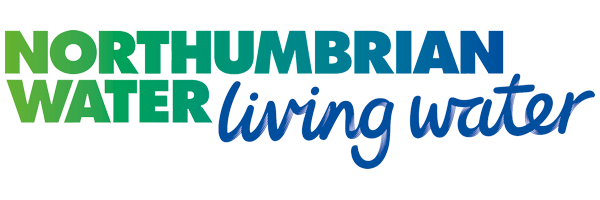Mosswood WTW (2024)
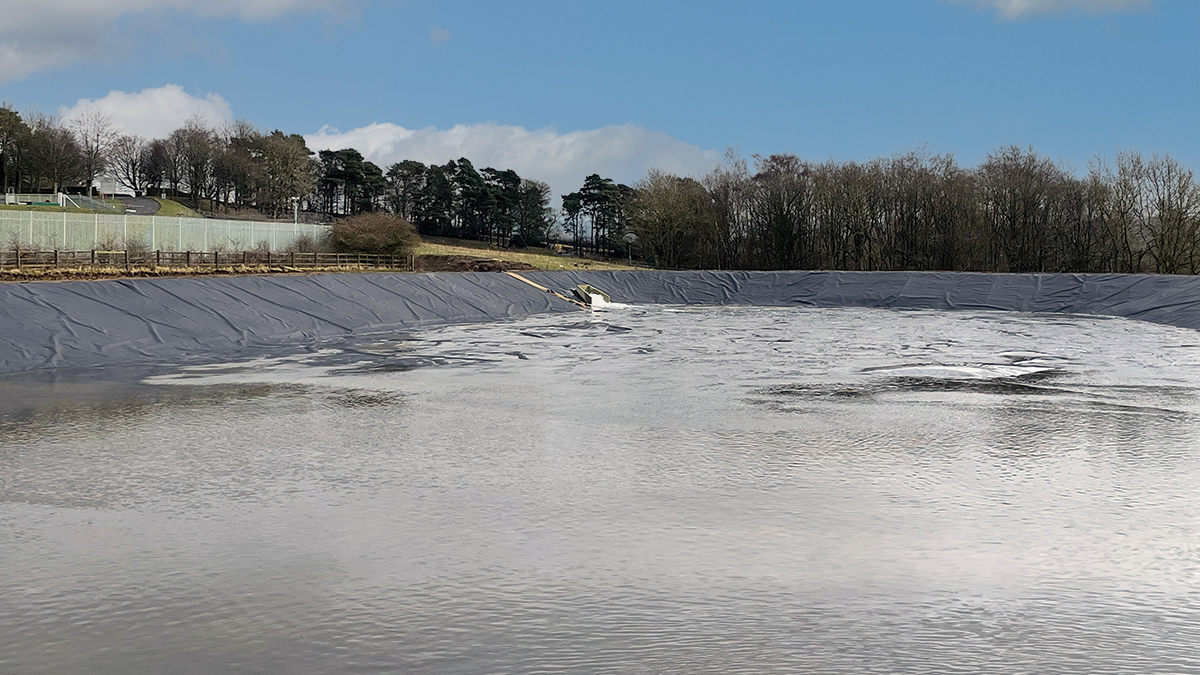
Lagoon during run to waste commissioning - Courtesy of Mott MacDonald Bentley
Mosswood Water Treatment Works (WTW) is located approximately 14 miles south-west of Newcastle, near Derwent Reservoir. The works has a maximum deployable output of 152 Ml/d and is of strategic importance to Northumbrian Water (NWG), serving approximately 1 million customers across County Durham, South Tyneside, Washington, and parts of Sunderland and North Tyneside The existing works consists of clarifiers, rapid gravity filters, UV disinfection and disinfection via chlorination, with two final water reservoirs on site. Following a Drinking Water Inspectorate (DWI) notice, NW required the installation of a new run to waste (RTW) system to discharge untreated water in the event of a process failure. This required an attenuation lagoon to be constructed to buffer RTW flows before they were discharged to a local burn, and Mott MacDonald Bentley (MMB) was commissioned under a Concept & Define (C&D) appointment followed by a Design & Construction (D&C) contract to design and implement this solution.
Outline design
At the outset of the C&D appointment, an outline solution for the RTW system had been developed by another contractor, transferring non-compliant waste flows from the treatment works, through a new 1.1 km pipeline discharging into the River Derwent. However, the Environment Agency had raised concerns regarding this solution due to the potential impact on river water quality.
MMB held a design sprint with NWG to review the solution and identify alternative proposals. It was highlighted that by incorporating an attenuation lagoon, NWG could construct the works within their existing site boundary and discharge to a local burn within 50m of the lagoon.
Collaborating with the NWG operations team to better understand the requirements of the system resulted in the required volume being reduced by 50%, representing a significant early saving for the project. MMB has significant experience of designing lagoons for water companies across the UK as well as the Coal Authority. The design team sought advice from colleagues involved in these schemes and sourced standard details to reduce design time.
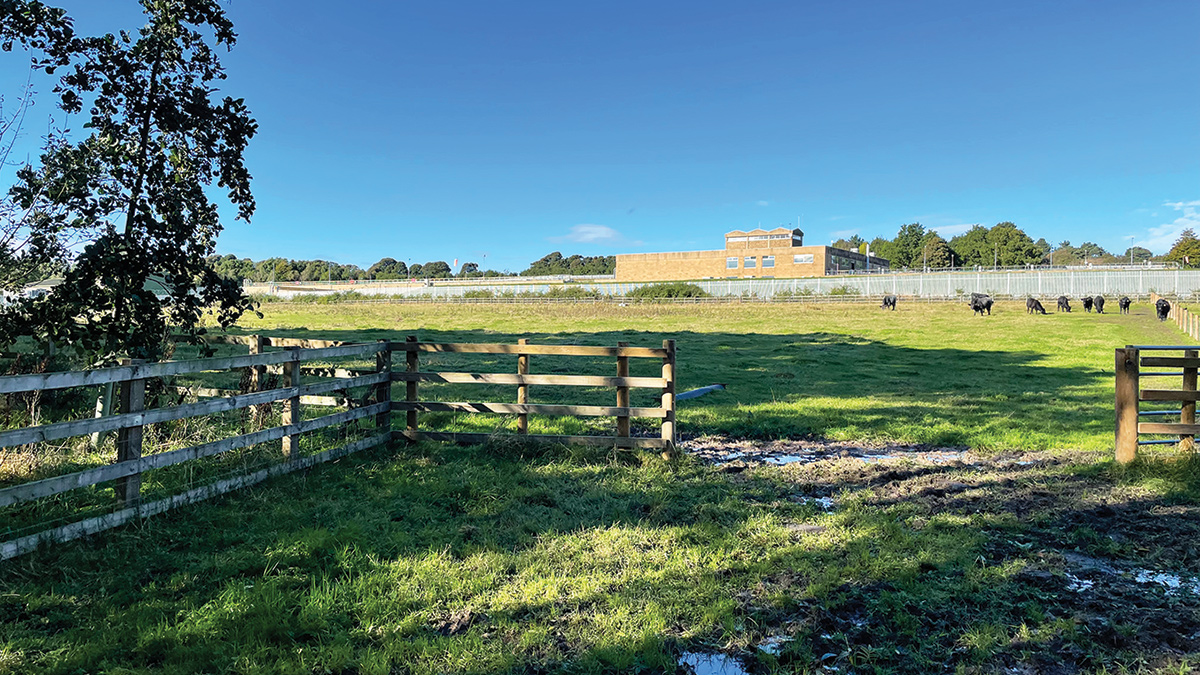
Field where the lagoon will be sited – Courtesy of Mott MacDonald Bentley
MMB changed the proposed RTW point within the treatment process from the clarifier overflow channel to the end of the rapid gravity filter (RGF) channel due to safety concerns over the constructability of the clarifier overflow option.
The outline RGF connection design required a section of the common channels to be isolated behind a temporary dam to enable installation of two 1.2m wide penstocks, which would need two RGFs out of service for weeks, reducing the site deployable output. MMB challenged the design and specified hot tap connections with gate valves located on the external wall, cutting the reduced output period from weeks to a matter of hours. The change kept the valves in the dry, improving maintenance access.
Ground conditions
A geotechnical desk study report was produced by MMB during the optioneering phase of the project. The desk study reviewed two sites and influenced the chosen location of the lagoon. Subsequently a project-specific ground investigation was designed to understand the possible geotechnical and geoenvironmental constraints.
The ground investigation was undertaken in March 2022 by Dunelm Geotechnical & Environmental Ltd and comprised four dynamic sample boreholes with rotary follow-on and 12 machine excavated trial pits. The information collected was summarised in a ground investigation report which identified made ground, variable glacial deposits and sandstone bedrock below the site.
During design, an earthworks specification was produced which allowed for reuse of site-won materials in the lagoon embankment, creating cost and carbon savings. The embankment compaction requirements were also defined in the specification, including in-situ validation testing. Slope stability assessments undertaken for the lagoon earthworks proved that the design of the slopes would be stable during construction and in the long-term scenario.
Discovery of an uncharted deep land drain adjacent to the perimeter of the lagoon within the initial excavation required unplanned diversions and extension of the land drains to mitigate the risk of the land drain carrying water underneath the lagoon liner. MMB installed a french drain system around lagoon to ensure any water would be drained away.
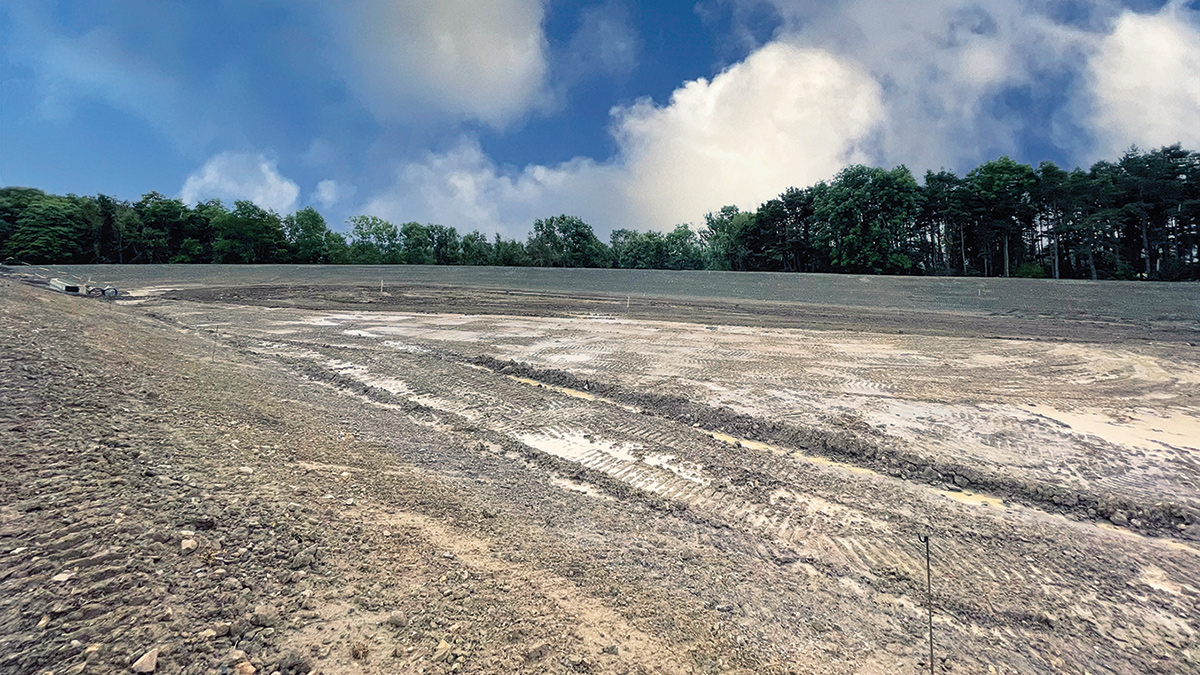
Early construction of the lagoon – Courtesy of Mott MacDonald Bentley
Digital delivery
Modelling software enabled the lagoon to be shaped organically to fit the field, increasing the plan area over concept designs which reduced the overall depth of the lagoon whilst still achieving the specified volume. This enabled the lagoon formation level to be raised above the underlaying water table, removing the requirement for lagoon under-drainage but critically also removing the requirement for a discharge pumping station, recognising a significant TOTEX saving and future maintenance. The system was hydraulically modelled using InfoWorks ICM, enabling pipes to be sized efficiently and minimising the number of required manholes.
The lagoon was modelled using Autodesk Civils 3D, which highlighted that the initial cut and fill volumes were imbalanced. The team identified opportunities to minimise over-dig and re-use excavated spoil across the site dynamically to reduce temporary stockpiling. A digital terrain model allowed use of excavators and dozers with in-built GPS and intelligent machine control. The model was combined with Synchro 4D Planning software to create a virtual simulation of the construction works, which, in combination with collaborative planning sessions, meant that MMB was able to identify and realise opportunities within the construction programme.
Mosswood WTW RTW: Supply chain – key participants
- Client: Northumbrian Water
- Design & construct: Mott MacDonald Bentley
- Ground investigation: Dunelm Geotechnical & Environmental Ltd
- Systems integration: EJ Peak Technology Solutions Ltd
- Electrical: Armah Switchgear Ltd
- Electrical installation: Intelect (UK) Ltd
- Underpressure wall connection: UTS Engineering Ltd
- Metalwork & pipework: Fluid Sealing & Environmental Ltd
- Diamond drilling: NML (Diamond Drilling) Ltd
- Lagoon liner: Celtic Lining Ltd
- Flow controls: AFFCO Flow Control (UK) Ltd
- Scaffolding: SWL Scaffolding Ltd
- Landscaping: Stuart Marley Ltd
- Security systems: Aceda Ltd
- Security fencing/gates: Middleton Forge Ltd
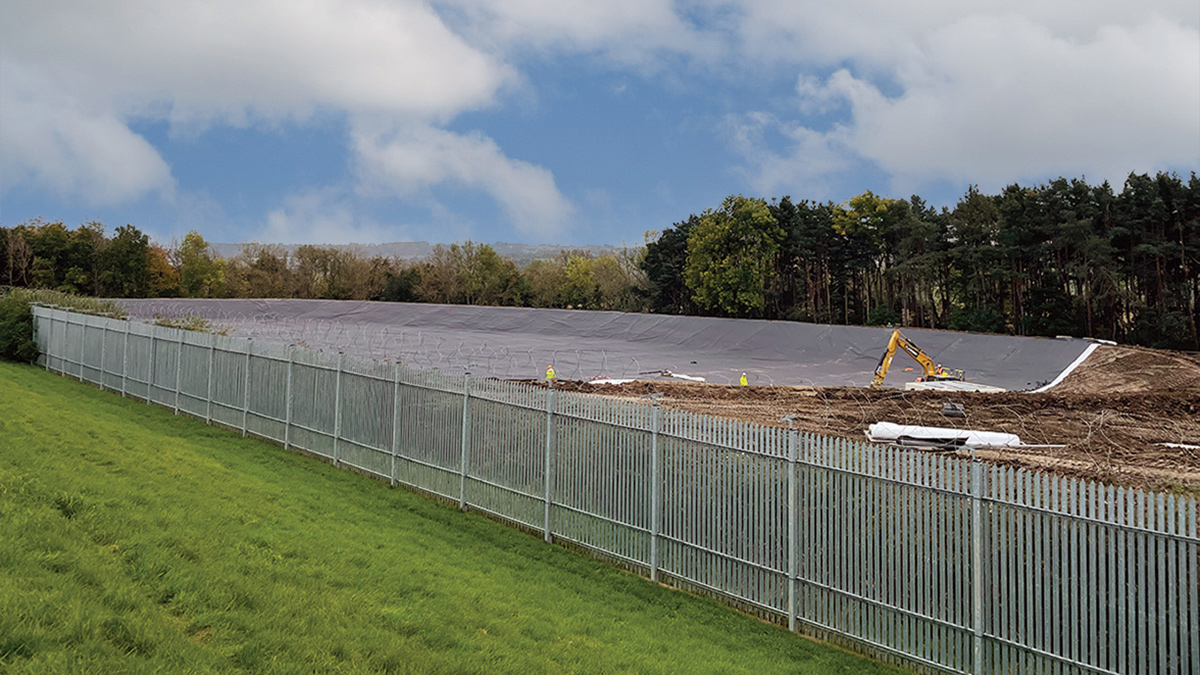
Lagoon liner installation – Courtesy of Mott MacDonald Bentley
Sustainability, climate change impact and carbon footprint
NWG own several fields around the WTW which have historically been used for sludge spreading. Some of the fields are now being utilised by the NWG conservation team to improve biodiversity and the old sludge lagoons are now home to great crested newts. MMB considered the ecological impact of the new lagoon from an early stage and was able to identify a field of lesser biological value to the south of the works within which to situate the lagoon. This ensured that the fields containing higher biodiversity value habitats were left undisturbed. MMB worked with Natural England to obtain a District Level License due to the proximity of the pond.
Water treatment typically requires chemical dosing to bring the pH of water into safe levels, which, when discharged to a watercourse can have a negative environmental impact. The RTW system was designed to minimise the impact of chemicals and selected an attenuation lagoon to buffer RTW flows before discharging to the environment. Lime dosing would be reduced before running to waste and temporarily storing RTW waters within the lagoon would allow any ferric sulphate coagulant to settle.
The maximum discharge flow rates to the River Derwent of 1760 l/s were reduced to a trickle flow of 10 l/s into a local burn.
Storing flows in the attenuation lagoon allows for temporary treatment equipment to be brought in, should water in the lagoon require further treatment before discharge. MMB designed out the requirement for a permanent pH correction system downstream of the lagoon by utilising existing dosing systems on site.
Because the negative cut and fill balance identified in the design required spoil to be brought in, an opportunity was identified to utilise site won surplus materials from another MMB site 15 miles away at Horsley WTW. The materials were tested for suitability and moved under a Material Management Plan; significantly reducing the associated carbon with the muck shift on two projects.
MMB utilised the Moata Carbon Portal to develop a baseline carbon footprint and then inform decisions throughout the design. At the end of the concept and define stage, the carbon footprint was calculated to be 270.3 tonnes CO2-eq. During detailed design, the carbon footprint was reduced to 146 tonnes CO2-eq, an overall reduction of 46%. Notable savings in the carbon footprint included:
- Changing pipe material from ductile iron to HDPE.
- Reducing the pipeline depth.
- Changing lagoon shape to reduce muck shift volumes.
- Removing the need for lagoon outlet pumps and associated pumping station via lagoon redesign.
- Combining four chambers into one.
- Decreasing the manhole chamber size from DN2400 to DN1800.
- Decreasing the access road length from 250m to 50m.
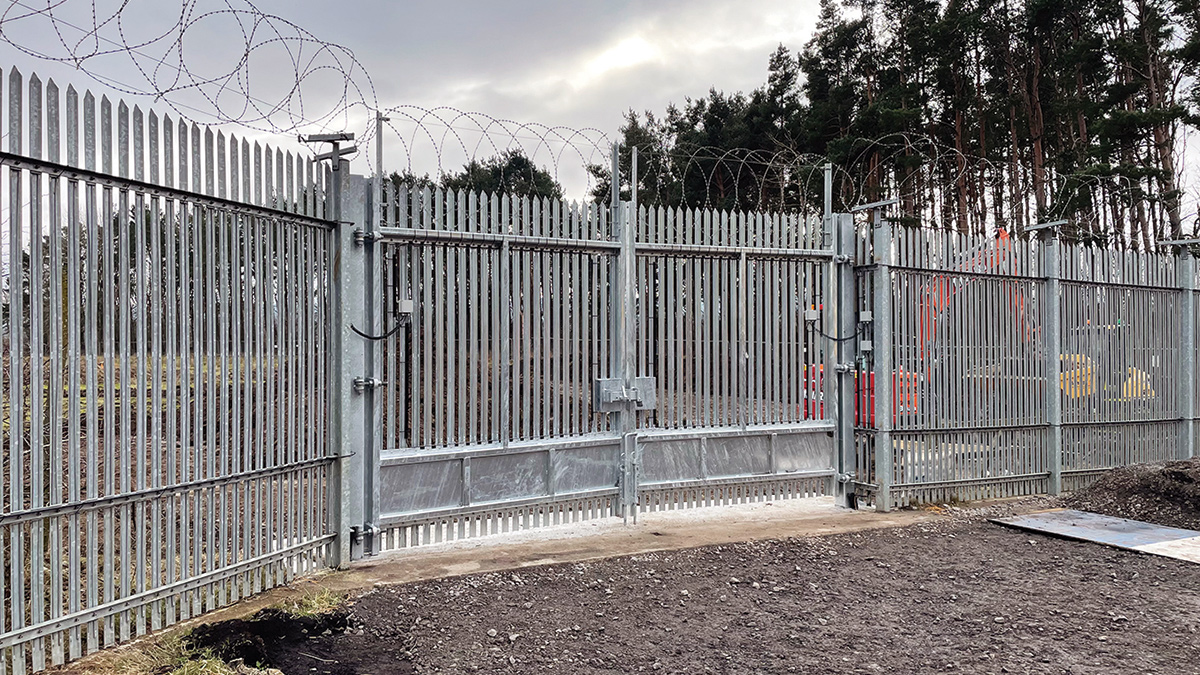
Security gate installed to allow access to lagoon area – Courtesy of MMB
Community benefits
A new access gate into the field where the lagoon was situated was constructed, avoiding plant tracking down Wallish Walls Road (public road), removing the risk of damage to the road and providing segregation from public traffic. Consideration of the cut and fill balance allowed wagon movements to be minimised on public highways and reduced temporary stockpiling on site, reducing the visual impact of the construction works.
Conclusion
Despite inclement weather conditions Mosswood RTW has been constructed without any unplanned disruption to the local water supply. The main construction works started in February 2023 and was successfully commissioned prior to the DWI undertaking date of March 2024. Overall completion and handover to NWG was in July 2024.
The use of 3D technology and lean planning techniques helped to minimise wastage on site, maintain excellent safety standards and find opportunity throughout the project programme. Over 26,000 hours were worked, with 1600 Safety Health Environment positive interventions being raised and zero accidents.
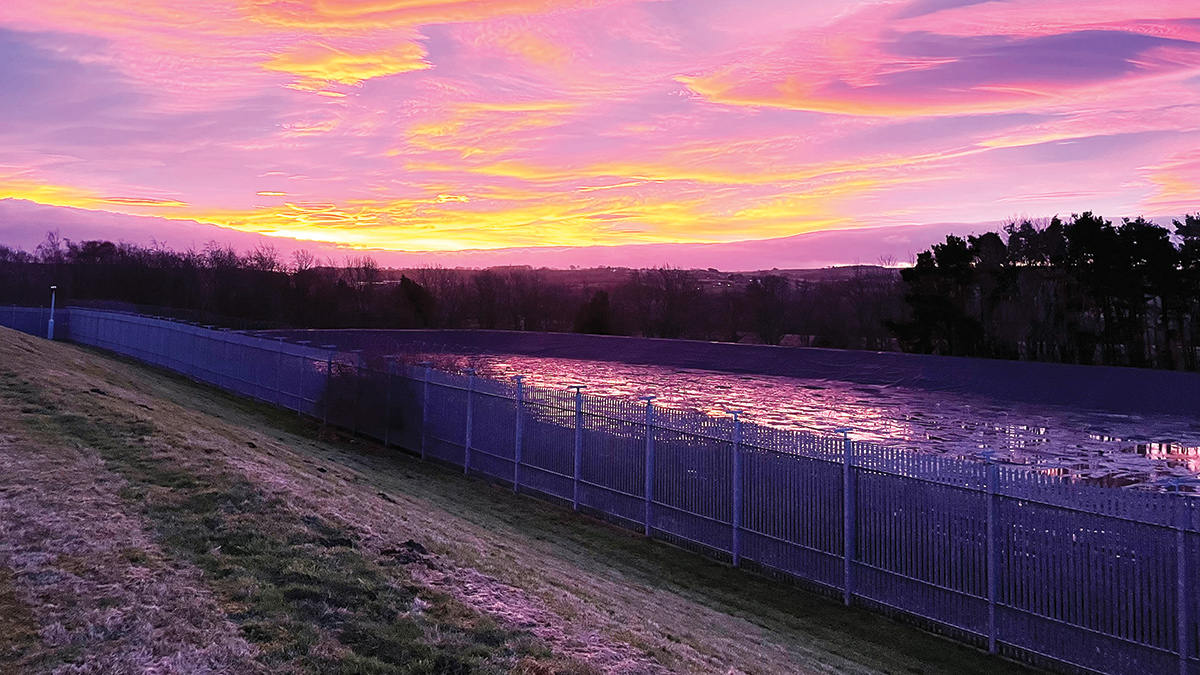
Sunrise over completed lagoon - Courtesy of Mott MacDonald Bentley



